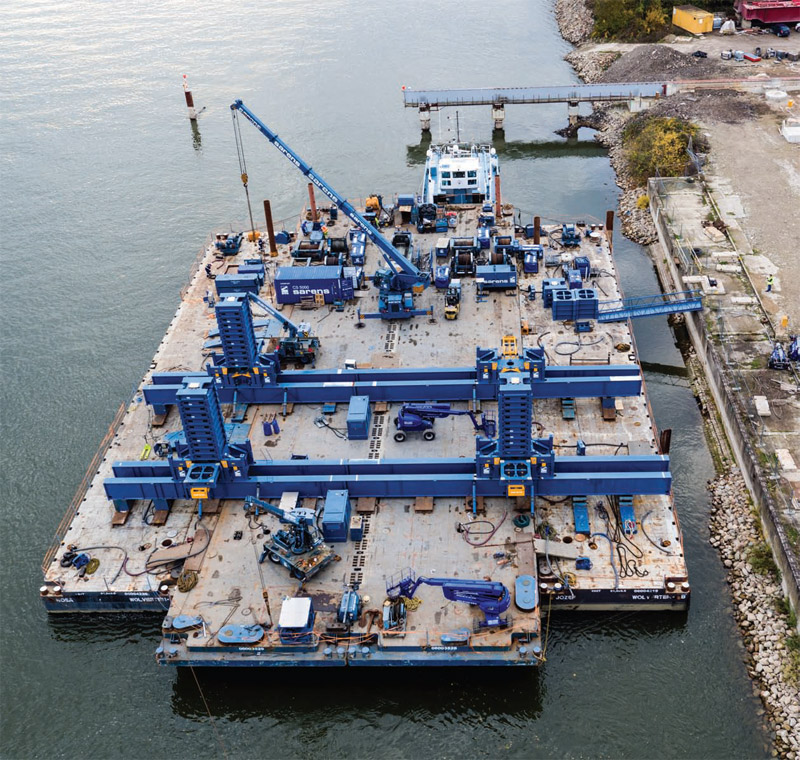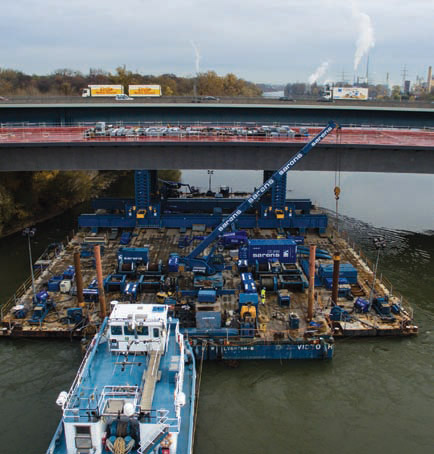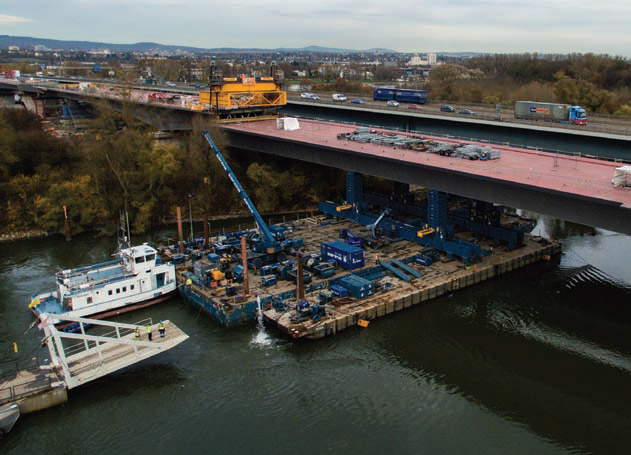Lifting while floating
17 February 2017Sarens has transported and installed a 2,000t segment of Schierstein Bridge using its new CS1000 jacking system. Sotiris Kanaris reports.
The Schierstein Bridge has spanned the river Rhine to connect state capitals Mainz and Wiesbaden in Germany since 1962. The bridge was originally designed to accommodate 23,000 vehicles a day, but within a few decades, it was straining under a daily load of 80,000 vehicles.
By the turn of the century, extensive corrosion had damaged the bridge beyond repair.
Authorities announced that the entire 1,282m-long structure had to be replaced. Today, a new bridge is being built alongside the old bridge in phases.
German construction company Max Bögl Group appointed Sarens to transport and install a 120m-long, 2,000t bridge segment for the new bridge.
Senior project manager at Sarens Peter Keyen tells Cranes Today that the company performs a number of similar jobs every year, but usually bridge segments weigh significantly less than this one, between 300 and 1,000t.
For this project, Sarens debuted its new CS1000 jacking system. “This is a 1,000t-capacity system per tower, and it can resist high horizontal forces. Depending on calculations, we can go up to 15m without any bracing and reinforcement,” says technical solutions equipment engineer Wim Charita.
Before the process of transportation and installation could start, the company had to make sure the river had the appropriate depth and that the water flowed at the right velocity.
The tremendous weight of the bridge segment meant that the Rhine had to reach a minimum depth of 3m.
Because of the unpredictable water flow, the company had to build a strong communication channel with the local authorities in order to get approval for the sailing and installation of the segment within a short time frame. The river had to be closed to outside vessels during the lifting process.
In order to combat the problem with water depth, the company decided to use four barges instead of two, as initially planned.
“We needed a certain level of water; with two barges it wasn’t possible to sail, so we had to add two more barges to reduce the draft. With a combination of four barges, we made one big barge. I think it was the greatest challenge of the whole project – getting into the right spot without touching the river bed,” Keyen explains.
The segment was built a couple of kilometres away from the bridge. It was skidded over two skid beams, picked up with the barge and then transported to the final destination.
To install the segment, teams had to reach the work site by boat, as it was inaccessible by land. The crew twisted the bridge segment into its final position and implemented the new CS1000 jacking system to raise it and complete the installation.
On the CS1000 jacking system, four towers were used to create stability, raising the capacity to 4,000t.
“We had to pick up the bridge at 2m and to place it at 7m, so we had to jack up 5m in this case,” says Keyen.
The team had to place ten 2t elements of 500mm on to the feeding system using a small crane.
The system automatically took the elements and jacked it up. In order to place it in the final position, Sarens installed strand jacks and lifted the segment another 4m.
The jacks pulled on the steel cables for 500mm at a time; when end height was reached, the Sarens team blocked the cables at the bottom. Then the jacks retracted and built up again, pulling up on the cables for 500mm each time.Although it was the first job for the CS1000, Keyen said that there were no problems and the segment was jacked up in 2–3 hours. The whole operation, including loading the bridge on to the barges, took two and a half days.
Expert bridge builders This was the second of four phases of this project, as the client is also building another bridge besides this one. Sarens will install the bridge segment for the other bridge in 2018 or 2019.
Despite lifting bridge segments using a jacking system being a typical practice in the industry for special movement, Keyen finds there is still a need to educate the market on the benefits of these ‘alternative’ techniques.
Keyen says: “We still have to convince our clients that there are alternative solutions to get a bridge into a position. Usually, when we explain to customers that we can do it this way or an alternative way, they are surprised. Then they calculate and see that it will cost less to do it with our solution than hiring a big crane on a barge or to assemble the bridge in many pieces at the final position.
“Most clients say no, they prefer the conservative way, and we do it step by step in small parts. It is up to us to prove to the market that there are efficient alternatives.
The techniques are there, and the lifting and skidding systems are constantly improving.”
The design of the CS1000 jacking system was based on years of experience with similar projects. Charita praised Sarens’s designers and engineers as the development process, from drawing to final testing, took under six months.
The system can handle very high horizontal loads while minimising limiting operation factors; for example, bad weather conditions.
“Because of the horizontal force we have inside the guiding system, it [is removed] from the jack and put in the tower directly through the base. This system gives us a lot of possibilities in terms of height,” says Charita.He adds that the system is accurate to 0.1mm in the synchronisation of up to an almost infinite number of towers.
This product stands between, in terms of the capacity, the existing Sarens CS5000 and CS600. Charita says the reason behind the launch of this product was an increase in demand for a fast, automatic build-up system with a 1,000t capacity in applications besides bridge construction.
He says an application that has become very popular is the lifting of container cranes employed for loading containers on to bigger ships.
“They can put intermediate pieces in between the legs of the container crane, so you install this system underneath the crane and you can lift it as high as you want,” Charita explains. Another application of the CS1000 could be to lift drilling rigs.
The range of jobs where the new jacking system could be used could be an avenue for new business for the heavy-lift and engineered transport services provider.


